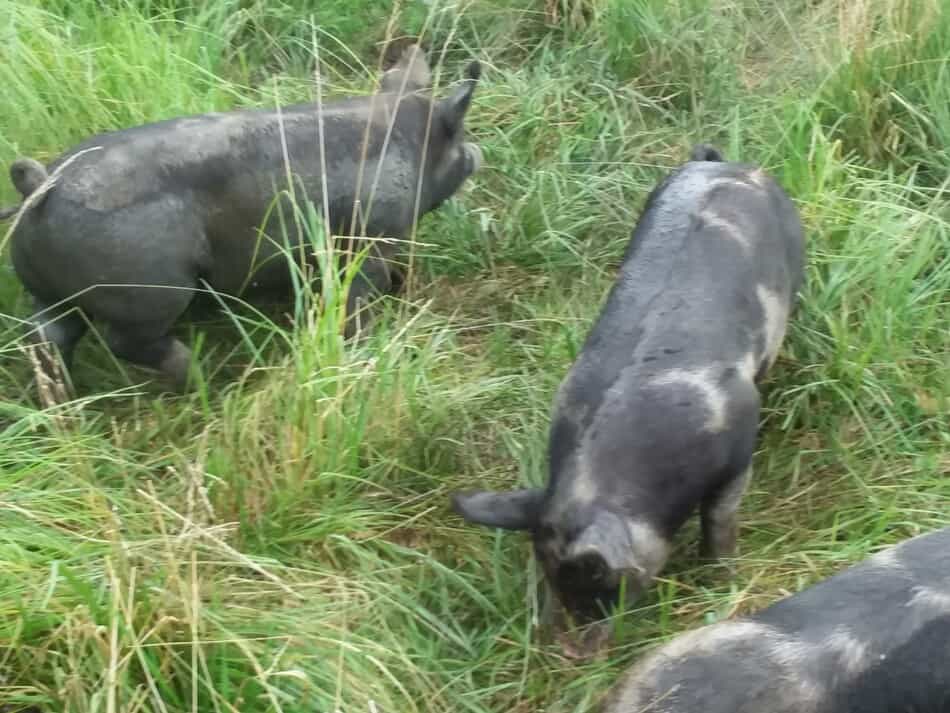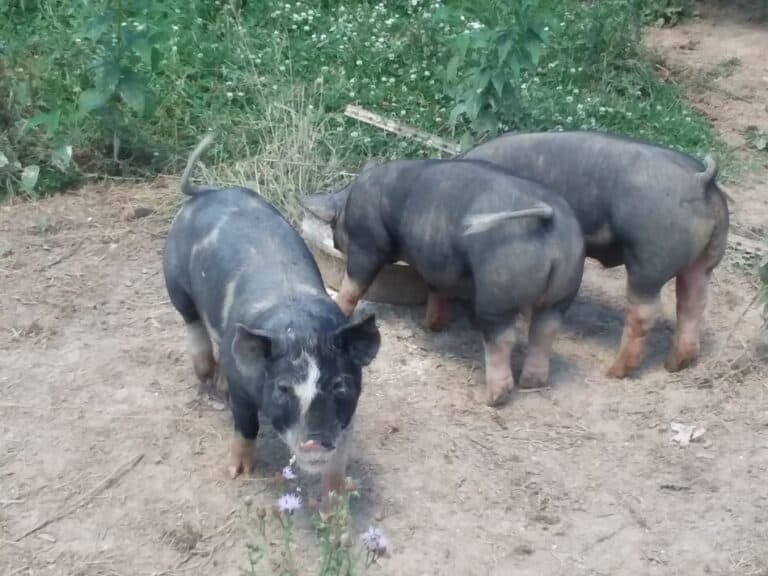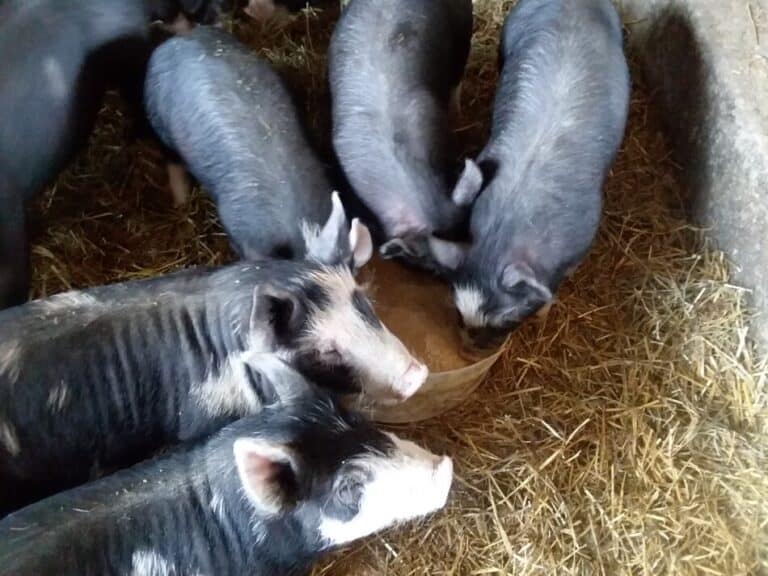How To Tell The Differences In Pig Breeds

There are quite a few pig breeds out there and they can look very similar, especially to a beginner! How can you tell the pig breeds apart so you can know which breed you are looking at?
The differences between pig breeds are visually determined using the traits of main body color, ear position and having or not having white markings on the body and comparing those traits with breed characteristics.
We’ll start off with a chart showing pig breeds with main color, ear position and markings listed. Main color and ear position are the most important to quickly identify the breed of pig.
| Pig breed | Main body color | Ear position | Markings |
| Berkshire | black | upright | face, feet and tail |
| Chester White | white | floppy | none |
| Duroc | red | floppy | none |
| Hampshire | black | upright | white belt |
| Hereford | red | floppy | white face, underside and legs |
| Gloucestershire Old Spot | white | floppy | smaller black spots |
| Landrace | white | floppy (large) | none |
| Large Black | black | floppy (large) | none |
| Poland China | black | floppy | white on face and feet |
| Red Wattle | red | floppy | none, has wattles |
| Spot | black and white | floppy | spotting pattern varies |
| Tamworth | red | upright | none |
| Yorkshire | white | upright | none |
Pig breeds are easy to figure out, one you know what to look for! There is one catch before we get started: pigs are frequently crossbred.
Crossbreeding makes a great pig, but it will also make breed identification hard, so this article will be most useful for identifying purebred pigs.
There is a small section on crossbreeding and color genetics is at the end of the article.
Best Pig Breed For Breeding Stock will go over the breed specific traits. Check it out if you want a comparison of showing the highlights and the pros and cons of each breed.
First, look at the main body color of the pig
The first step to identify the breed of a pig is to note the main body color.
When you take a quick glance at the pig, what is the main color you see? This is the first thing we need to know to figure out the breed.
The three main colors of pigs are white, black and red. Remember, we are looking at the main color, a bit of additional color will be sorted out later. Just concentrate on the color you see the most of.
What Is The Best Pig To Raise? will show you the best pig for you to raise for meat.
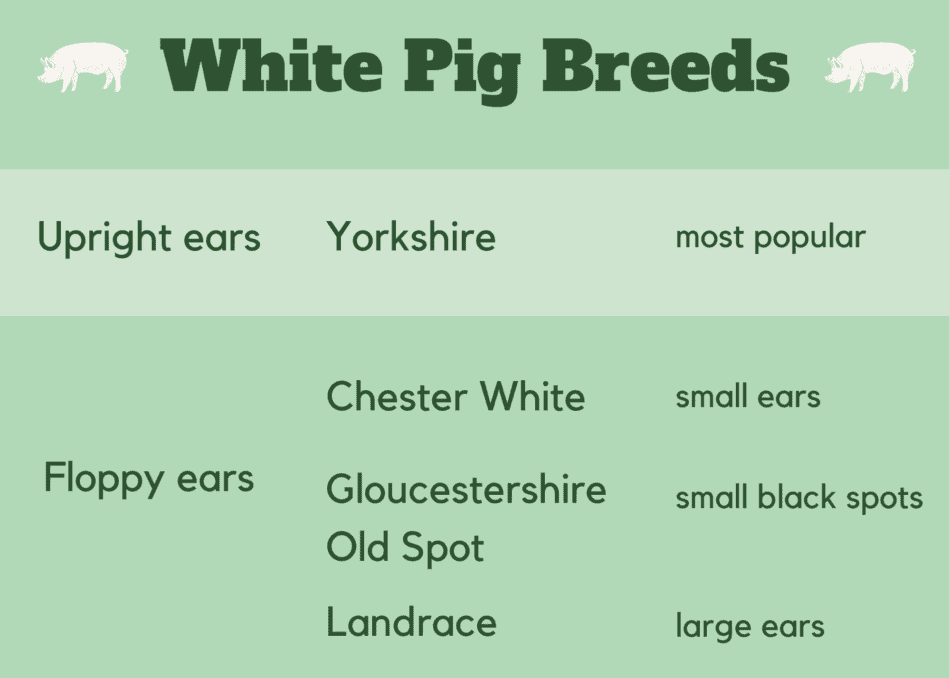
White bodied pigs are the maternal breeds
The white bodied pigs are the maternal breeds, Yorkshire and Landrace being the most popular with Chester Whites as lesser known, but great choice, as well.
These three breeds of pigs will be 100% white, no black spots at all.
You can see from the graphic, in the white bodied pig section there are Gloucestershire Old Spots (GOS), also a maternal breed, which have a mostly white body and a few small black spots.
These pigs tend to be longer bodied and sought after as sows, since they are good moms that have lots of milk for lots of piglets.
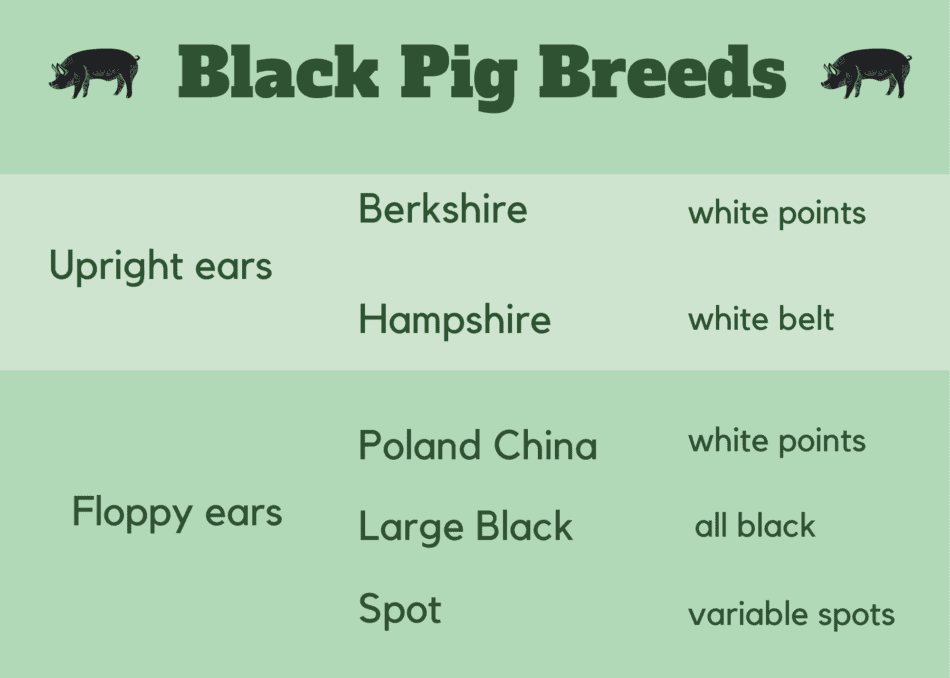
Black pig breeds can be solid black or have white markings
The black pig breeds have an entirely black or mostly black body.
The Hampshire has a white belt around the ribs, just behind the front legs. Berkshire and Poland China have “white points” meaning white on the face, feet and tail.
The Spot has quite a few large spots and ideally is 50% white and 50% black, but I put it in the black breeds section since it is a split off of the Poland China.
The Hampshire is the most popular pig in the black breed group.
They are often used as sires in commercial pig operations and are the most easily recognized pig in this group, due to the flashy look of their distinctive white belt.
The black pig breeds are usually thought of as meat breeds, with the exception of the Large Black, which is more of a maternal breed.
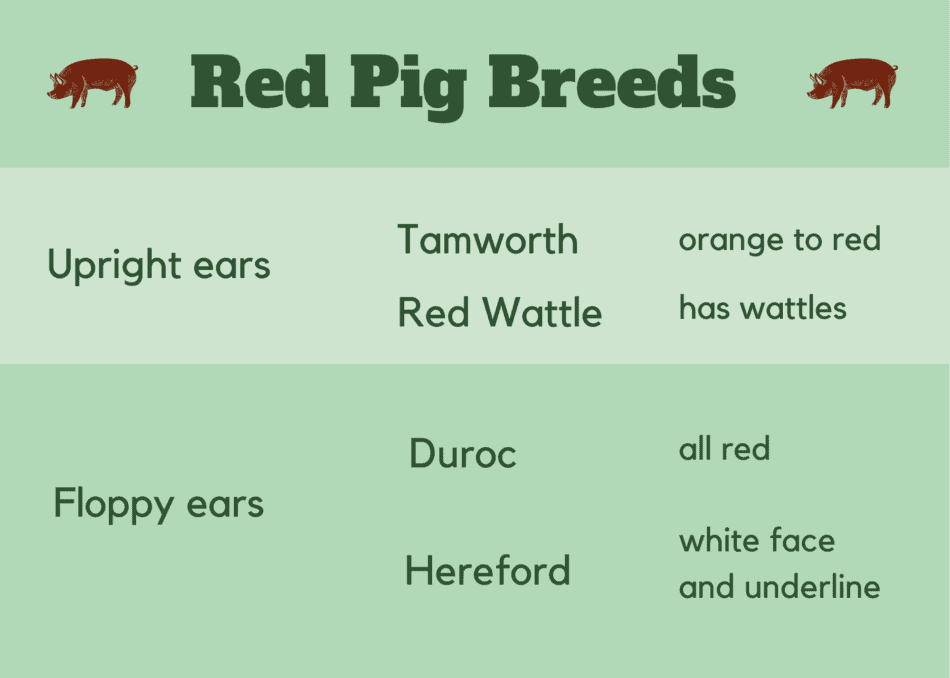
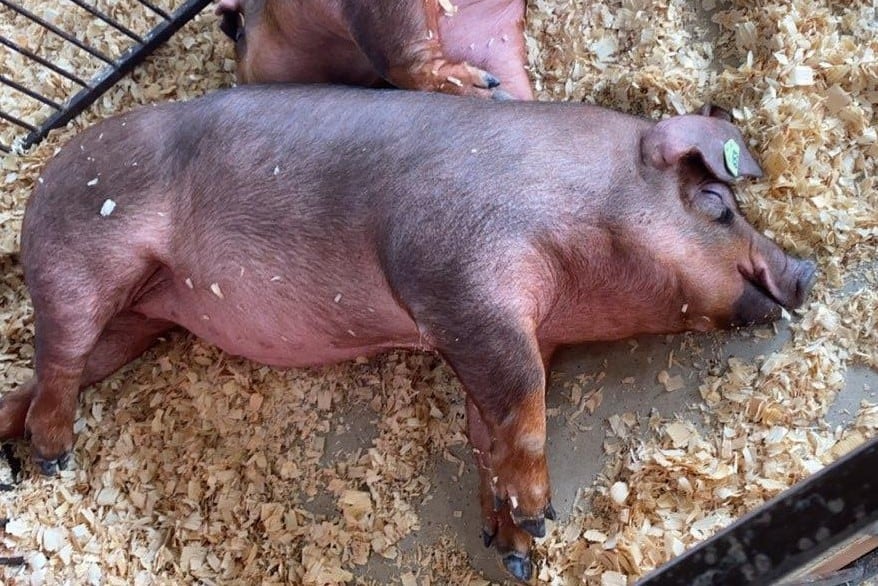
Duroc is the most popular red bodied pig
Red bodied pig breeds are normally solid red.
When you think of a red pig, chances are you are thinking of a Duroc, but did you know there are other red breeds, as well?
Duroc, Red Wattle and Tamworth are solid red pigs with the differences being in the ears (floppy on the Duroc, the other two are upright) and, of course, the wattles on the Red Wattle.
Hereford pigs are easy to identify, since they have an entirely white face and all of the other red breeds are just red.
Of the red pigs, Duroc are the most popular, with Hereford, Red Wattle and Tamworth being much less common.
Second, note the ears: upright or floppy?
Now, the second key to pig identification: the ears. You’ll see upright or floppy ears.
The ear position (upright or floppy) combined with body color (white, black or red) will identify the majority of pig breeds.
An easy thing to remember is that the upright ears are the “shire” breeds, Berkshire, Hampshire and Yorkshire.
Floppy ears come in two sizes
Floppy ears come in two sizes: larger which seems to cover most of the face or smaller floppy ears which are shorter in length.
The only breeds that I can think of, off hand, that look the same except for the ear size is Landrace and Chester White.
Landrace has the long, floppy ears and Chester White has short floppy ears, both are 100% white in color.
When you get better at breed identification, you’ll also notice the body shape differences between breeds, but for a beginner, it’s easiest to stick with the combination of body color and ears.
Here’s a quick example of ears indicating the breed: let’s say you are looking at a pig that has a mostly black body with white points (a bit of white on the head and white feet). Which pig is it?
Well, you need a little more information, since the pig could be Berkshire or Poland China.
Since we are in the ears section, you’ve probably guessed it, the difference is in the ears!
If the pig has upright ears, it is a Berkshire. If the pig has floppy ears, it is a Poland China.
As you get more familiar with pigs, you would also notice some body shape differences, Poland China is a bigger pig, but for now use the ears!

Third, note the white markings on body, feet and head
The presence or absence of white markings on a pig is used to determine pig breed after the combination of body color and ear position did not result in identification of the breed.
Are there any white markings on the pig? Look at the face, feet, underside (belly) and tail. Normally, you’ll know what pig you are looking at before you get to markings but occasionally, you need to consider this.
An example of markings making the final breed distinction would be between Hereford and Duroc. They both are red bodied pigs with floppy ears. Now what?
Well, this is pretty easy, since the Hereford has a white face and underside, but the Duroc is red only.
Knowing which breeds have white markings are going to be less helpful than remembering body color and ear position, so concentrate on learning color and ear position first.
Lastly, note the snout: is it long or short?
Some pig breeds have an unusual length snout, either unusually short, like a Middle White, or unusually long, like a Tamworth.
This is a minor point, how long is the snout or the nose? Actually, if you are using body color and ears, you shouldn’t need to consider snout, you should already have the answer!
Just in case you want a bit more information, we’ll go over it quick.
The snout on a pig can be long, medium or short. Most farm pigs would have a medium snout. Medium snouts look normal, anything weirdly long or weirdly short is a different, non commercial breed.
Long snouts make the Tamworth stand out. They are red with upright ears, so that’s enough to make them not a Duroc or Hereford, but I will concede that the snout is the first thing to grab your attention!
Unusually short snouts are the main feature of an old breed, the Middle White, from England, not in any of the main farm pig breeds.
Here is a nice, easy to read article with great pictures of the 8 major swine breeds, if you are interested.
Small breeds or unusual breeds of pigs have a different shape
If you are looking at one of the newer pig breeds or an unusual pig breed, like Guinea Hogs, the rules above do not apply.
These breeds have a different body shape (blocky) and stature (shorter) than most commercial pigs.
Some of the new breeds also have wattles, a shorter face and generally very interesting color patterns. I have never had any of these type of pigs, so my breed identification if for farm type pigs only.
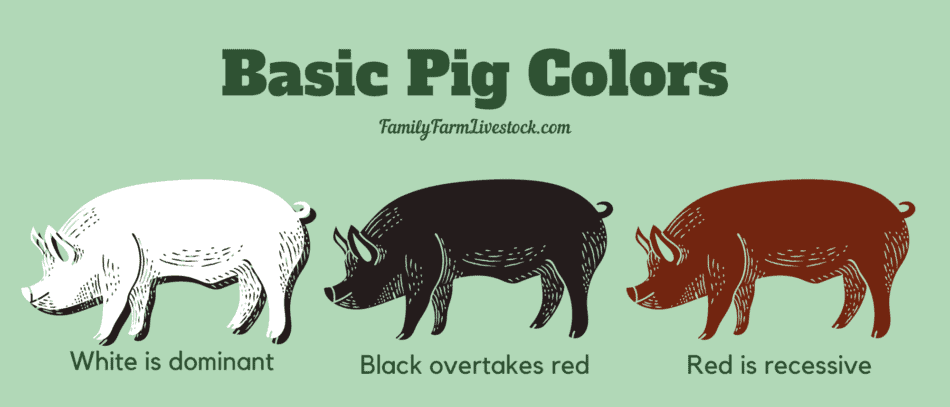
The basic pig colors are white, black and red
Now, we’ll go over some of the color basics with pigs. This will apply to pigs that are crossbred, meaning their mom is one breed and their dad is another.
Crossbreeding pigs is super popular for producing fast growing and hardy feeder pigs. If you have a feeder pig that you are not quite sure of the breed, this may be why!
The 3 basic color choices in pigs are white, black and red
If you are looking at a purebred pig, the main color will be white, black or red.
There is a reason I listed the colors in this order, white is the most popular pig color, as far as numbers go, because white is dominant in pigs.
White is the dominant color in pigs
White is the dominant color in pigs. White pig breeds always have white piglets, but so do white pig breeds bred to another non white breed!
This means if you breed an all white pig breed to a black pig breed you’ll get white piglets! All of them. Genetically, these piglets are half white half black, but the only color that shows is white.
The same goes for a white pig breed bred to a red pig breed, all of these crossbred piglets will be white. Genetically, these piglets are half white half red, but the only color that shows is white.
You can tell a crossbred by the skin speckles on it’s back and butt, they are grey. The hair is still white, but the skin has grey splashes, showing you that the white looking pig is actually a crossbred.
The pigs with the grey splashed on their backs and butts are called “blue butts”. A funny name for a very popular feeder pig cross!
Black body color in pigs will over take red, but not white
This is where things get interesting, black is kind of middle ground color in pigs. You’d think that if you breed a white pig to a black pig, you would get grey, but you don’t. Colors don’t mix like that in pigs.
Black gets taken over by white, if one of the parents is from a white breed all of the piglets will be white. However, a black pig breed bred to a red pig breed will produce black piglets!
Red body color is recessive
Red is the recessive body color in pigs, meaning red gets taken over by the other two colors. If your pigs are red, then both of their parents are red!
If your pigs have one red parent and one white parent, the litter will be partly white or 100% white, depending upon the genetics of the parents, but it will never be 100% red.
That only happens if both parents are red.
Markings can pass down in crossbreeding pigs, especially the Hampshire belt
The last thing you may see is something like a red pig with a white belt, how did that happen? Well, there are Hampshire genetics in there somewhere!
Pigs can also have unusual spots, partial markings and three colors, kind of like a calico cat. Once you start crossbreeding, you never know what color genetics will show up!
